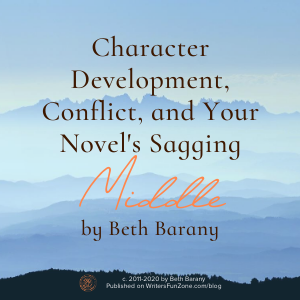Character Development, Conflict, and Your Novel’s Sagging Middle by Beth Barany
 When authors work with me, some of their challenges surround how to help the sagging middle of their novel. That sagging middle is often due to not knowing their characters well enough. All good conflict, in my opinion comes out of your character’s worst fears.
When authors work with me, some of their challenges surround how to help the sagging middle of their novel. That sagging middle is often due to not knowing their characters well enough. All good conflict, in my opinion comes out of your character’s worst fears.
You may have heard the saying, “Put your character into a tree and through stones at them.”
When I first heard that, I was terrified. What? I had to do bad things to my lovely precious characters?
Yes! My critique group shouted at me, politely.
Okay so I went about the hard work of figuring out how to create realistic and ever-escalating conflict for my dear characters.
Now I want to back up a step. You still need to understand all the other aspects of your character:
- What they want (Goal)
- Why they want it (Motivation) (See Deb Dixon’s book, Goal, Motivation, Conflict, for more on his topic.)
- Strengths (Deb’s book doesn’t cover this; it’s my innovation to her robust and useful book.)
- Hobbies (My husband always asks people this; it’s such a great opener.)
- Lifestyle (Social drinkers? Salsa dancers by day; Porche drivers by night? Could be!)
- The way they dress and why (Are they preppy, wearing custom corporate apparel (like company shirts or polos), because they want to get into the country club; or do they wear the latest grunge apparel because they’re part of the underground resistance and their clothes are all hand-me-downs?)
- What they carry in their pockets (See Tim O’Brien’s book, The Things They Carried, for inspiration on this.)
Okay. That’s a start.
Let’s get to the heart of conflict for the character.
To know what kind of stones I should throw at my characters, specifically my main characters, I like to brainstorm all these points, then my goal is to prioritize them. I’ll get to the prioritization in a moment.
- Childhood scarring trauma (This event defines the character’s limited sense of self that needs to get healed in some way so that the character can succeed by the end of the story.
- Phobias (This could or not come from the childhood scarring trauma.)
- Irrational fears (Same as phobias. (This could or not come from the childhood scarring trauma.)
- A list of the worst things that could happen to my character, at least 10 things with ever-escalating real or imagined danger. Push the envelope of your tolerance here. End with the real or feels-real death for your character, whichever is appropriate for your genre.
- Secrets from herself. What she can’t even admit to herself but maybe others know.
- A secret from herself and one that others don’t know.
- Secrets she must keep from others or else? (What is the “or else”?)
Once you’ve brainstormed this list, then prioritize the bad stuff from the least impact to your character to the biggest impact. As I was reminded from a Steven Pressfield post, make sure that your character faces a real or imagined death. That is really what we’re heading towards.
Once you’ve got your stones lined up, start lobbing at your character. Then voila, your sagging middle will disappear, and you’ll have a lean, robust middle of your novel that will keep your readers at the edge of their seats, turning those pages.
And that, after all, is our goal.
***
ABOUT BETH BARANY
 An award-winning novelist, Beth Barany writes science fiction and fantasy for young adults and adults. Her first novel Henrietta The Dragon Slayer won Grand Prize in a California Indie Author contest.
An award-winning novelist, Beth Barany writes science fiction and fantasy for young adults and adults. Her first novel Henrietta The Dragon Slayer won Grand Prize in a California Indie Author contest.
Based in Oakland, California, with her husband, Ezra Barany, also a novelist, Beth has lived abroad three times — Quebec and twice in Paris, France — and speaks fluent French.
Known for creating rich world, tough and kick-ass heroines, and refreshing romances, Beth creates cinematic stories to empower readers to be the heroes of their own lives.
When she’s not penning rip roaring reads, Beth runs an online school for fiction writers, speaks at conferences and international cultural centers, most recently in Saudi Arabia, and enjoys her many dragon figurines sprinkled throughout her house.
For freebies, excerpts, and more about her books, go to Beth’s site: author.bethbarany.com.







I sag all by my self, now I have to see if my new novel is sagging. I think it is.
My main character talks to him-self.
thanks for the great suggestions.
Malika, LOL. Most characters talk to themselves! You’re welcome, and thanks for stopping by.
I enjoyed your article. I am going to use it to help me get to know my main character better. When I first started writing, I hated the conflict part. I mean, in real life, I hate conflict. I do not love having anything bad happen to my dear characters – unless I can put purpose to it.
But still, I think that is one of my weakness as a novelist, I do not totally embrace conflict and so my stories probably lack a little depth.
But I am still having fun writing both novels and blogging and I really appreciate some of the tips you shared!
Wendy, I totally hear you! I had so had that problem too! One thing I forgot to add to this post was asking the question, “What’s the worse thing that can happen to my character right now in this scene?” Then I dare myself to write it. If I don’t like it, I can also hit delete. Glad I could help! Keep up both the novel writing and the blogging!
Great blog post! Love how you suggest deeper character development to tighten up the weak parts of the story – it’s easy to assume that it’s due to slack of tension (weak arc), but of course, there can be other things to it than that. May I refer to your post on my blog? Character development has more or less been the theme of the week there, and I feel this would really add to it!
Thanks for an inspirational blog 🙂
Thanks Linda! Please do refer to my post on your blog. I’d be honored! And you’re welcome! 🙂